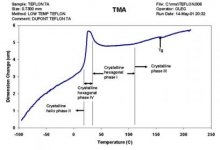Laverda
Cast Iron
- Joined
- Mar 24, 2014
- Location
- Riverside County, CA
I need to make some parts out of PTFE. As it is expensive stuff, any advice anyone can offer so I don't waste the material? I have in the past made the same part out of bronze and other plastics with no problems but have been asked to copy it in PTFE which I have never worked with.
Will be done on a manual lathe which only goes to 1800 rpm. Part is 3" in diameter and after turning will have a small amount of milling done to create a hex on one end.
So, I was thinking HSS would be the best choice? I have all the grinding equipment needed to make a razor sharp tool but what geometry on the tool?
I don't want to waste $2000 worth of material because I have no idea what I am doing!
Will be done on a manual lathe which only goes to 1800 rpm. Part is 3" in diameter and after turning will have a small amount of milling done to create a hex on one end.
So, I was thinking HSS would be the best choice? I have all the grinding equipment needed to make a razor sharp tool but what geometry on the tool?
I don't want to waste $2000 worth of material because I have no idea what I am doing!



 )were down to the coolant actually heating the part !!!
)were down to the coolant actually heating the part !!! $$$$ ..................look up the price of the same sized piece of PEEK!
$$$$ ..................look up the price of the same sized piece of PEEK! ..............I've seen some right Lulus, and declined to quote many of them.
..............I've seen some right Lulus, and declined to quote many of them.